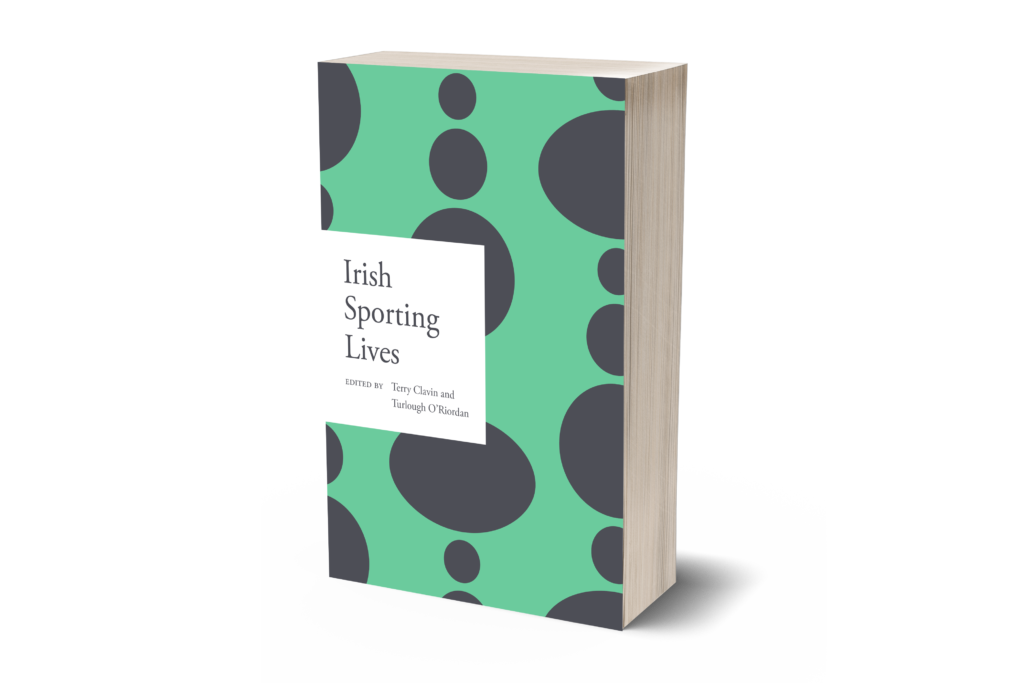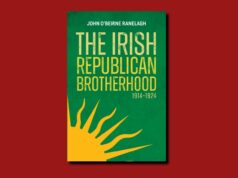

Serial winners and glorious losers, heroes and villains, trailblazing women, role models and rogues, all are here; so too are audacious sporting founders, enduring legends and forgotten or overlooked greats. Through a selection of sixty lives from the Dictionary of Irish Biography, this book celebrates the diversity of Irish sporting history.
Serial winners, glorious losers, and trailblazing women—Fiona Murphy talks to Turlough O’Riordan and Terry Clavin, editors of Irish Sporting Lives (Royal Irish Academy)
‘Well, what do we have, Turlough? We have croquet, and hockey,’ Terry Clavin, one of the editors of Irish Sporting Lives asks his fellow editor, Turlough O’Riordan.
‘Archery, hockey,’ Turlough replied.
‘Rock climbing, show-jumping,’ I supplied.
We’re speaking over Zoom, as is the done thing these days, and beside me is the vibrant green copy of the book they’ve edited together, a collection of sporting lives from their project, the Dictionary of Irish Biography with the Royal Irish Academy.
A project designed to explore the island’s life story through its biographies, Terry and Turlough had the gargantuan task of selecting just 60 lives to focus on from their archive of over 500 Irish sporting stars.
This isn’t your dad’s Christmas present of a sports biography.
A collection of 5-10-page mini biographies covering 60 of Ireland’s most interesting sporting lives, Turlough and Terry went into this collection with the aim of changing the lens through which we view Irish sporting lives.
‘We tried hard to reach out,’ Turlough tells me. ‘We didn’t want to have a book full of Kerry and Dublin Gaelic footballers, or Cork and Kilkenny hurlers, even though we have some of them in there. We wanted to collect the widest possible experience.’
These bite-size, mini biographies step off the beaten running track, and comb through the archives for the serial winners and glorious losers, heroes and villains, trailblazing women and complex role models, resurrecting the forgotten and rediscovering overlooked legends. So how did they choose who deserved a chance at immortality in these pages from an archive of over 500 people?
‘The people, the lives, the sport, what period and where they came from all influenced the decision.’ Turlough O’Riordan is the online digital editor of the Dictionary of Irish Biography and has a deep and intimate knowledge of the collection, having spent the last two decades immersed in it.
‘There’s no one before 1800, just because there’s no material there. There’s not really organized sports before that period,’ Terry explains. ‘I suppose around 1870 is when we see proper organized sports really begin to develop. Once you get into the late twentieth century, people are still alive, so they don’t feature.’
‘We definitely wanted to get people familiar with the sense of the strangeness of the past.’ Terry Clavin joined the Dictionary of Irish Biography project in 2006 and has published over 400 biographies of the lives stored there. ‘You have these sports you think you’re familiar with and you read about them a hundred years ago and they seem very strange.’
This strangeness comes from the evolution of various sports and through the lens of these biographies, we can map the changes that would render some of our modern iterations of organised sports almost unrecognisable to its greatest champions a hundred years ago.
‘With boxing, you can see it evolve,’ Terry tells me. ‘You start off with bare knuckle brawlers, like Dan Donnelly, where you’re allowed gouging and hair pulling and kicking and throwing people to the ground. And then you have someone like Jack Dempsey, who’s late 19th century, and his career is about the transition from bare-knuckle to wearing padded gloves to Queensbury rules, and then you have something that looks like modern-day boxing then, in the last two entries.’
Timeline
This book is a timeline, as much as it’s about the players. We can track the evolutionary milestones of Irish society and sports through changes of social attitudes, the move towards professionalism, as well as the media’s and subsequently, money’s involvement in Irish sporting life.
‘The Michael Cusack entry, you have the establishment of the GAA. I suppose that was a big milestone. You have the facilities being put in place and Dunlock, he’s someone who goes around and sets up loads of sporting organizations. He helps set up Landsdowne, he sets up a big athletic track on Lansdowne Road, and a rugby pitch, of course it becomes more famous as a rugby pitch. But it was originally envisioned as an all-around sports arena.’
‘As Terry says the codification,’ Turlough chimes in, ‘the kind of themes of foreign and domestic games and how they interacted–the bans that inflect each other, soccer, camogie, hockey, foreign games, rugby league, rugby union…But what’s really interesting about soccer is the pragmatism of soccer in the twentieth century. People would play for both the Northern Irish and the Irish team and there’s the constant issue there of, even though there’s a partition and a great political divide, there’s almost a pragmatism there. To me the biggest milestone is people stay engaged with sport for probably the same reasons, just in subtly different ways, both as fans, competitors, and now we have professionals.’
‘The move to money coming into sport and the role of the media is also a milestone. I mean you see the media are there from the start. First print media, which is very important to publicize sport in the late 19th century,’ Terry explains. ‘And then later on you have television making a big impact, giving sportspeople a whole new level of fame. I think you see that in the entries on George Best, in particular, that he achieves a sort of rockstar level of fame that a footballer had never achieved before.’
Media
I presumed, like I’m sure many others might, that the media’s relationship with sports stars must surely have changed over time to become the tempestuous machine that it can be now, either catapulting you to fame or bringing you crashing back down to earth as quickly as your star rises. But Terry quickly corrects that presumption of a simpler time.
‘We see that right from the very start, even with Dan Donnelly. He’s a bare-knuckle brawler in the 1810s and he’s Ireland’s first sports celebrity, really. He achieves a huge level of fame and he’s commemorated in ballads and songs, and he wins his fights and is brought out through Dublin on a white horse.
‘But he also has a drinking problem, the fans are always supplying him with drinks. He’s giving an exposition in Donnybrook and people keep buying him drinks, with predictable consequences, so you see it right from the start.’
Talk turns to the idea of legacy. Forgotten heroes, unforgettable failures, the tragic, talented lives cut short – would they feel disappointed to be lost to the archives or do they think they expected to end up there at all?
‘I think a lot of sports stars tend to have big egos so most, I’d imagine, want to be remembered for a long time and probably be disappointed!’ Terry laughs, before adding. ‘Most people don’t get remembered, I suppose would be the most brutal way of putting it. It’s kind of fascinating to see, if you retire from sports, potentially in your early thirties, and you could live another 60 or 70 years. I suppose you could say they’ve outlived their reputation, by the time they die. I mean May Hezlit, brilliant golfer for the first decade of the 20th century, and she’s at her peak at the age of around 16, she retires around 26 when she gets married. As far as we can see she barely picks up a golf club after that, and I think she lives to nearly 90. So we’re talking about 70 years in obscurity.
‘Maybe the worst thing that can happen to some of these sports people is to live a long healthy life after they retire because they get to be forgotten,’ he muses. ‘Or of course, as we notice from this volume, an early death, particularly a romantic early death, is great for your reputation. Dave Gallaher, the rugby captain, dies in World War One, Joey Dunlop, is killed in a race, so they’ve been remembered.’
Women sports stars
And with the idea of evolution and legacy at play, I’m interested in how this collection works to hold up these women sports stars of the past and give them the recognition that they perhaps didn’t receive in their own eras. In appreciating them now, we can see how far we seem to have come, but what changes did the two researchers see in the female sporting experience – and has it changed as much as we like to think it has?
Turlough says: ‘To me what is most interesting is the experience of the women, what they can highlight about then and now. I talk to my young nieces about camogie or tennis and their mind boggle at this kind of stuff. Some of this is almost within our parents’ lifetimes, in the 40s and 50s and 60s.’
‘Brede Arkless is climbing while she’s pregnant,’ he lists. ‘Anne O’Brien is breastfeeding in the changing room at halftime. These barriers, these impediments for participation are just everywhere for women and clearly nowhere for men. Do I think it’s getting better? I hope it is, but I think all these organizations are still incredibly gendered and blinkered to varying degrees. They represent the society they emerge from.’
The simple act of participation in sports by a woman is inherently political at the time, as Terry explains.
‘I’m struck reading our female entries. Even if they’re not very political themselves, they’re almost political just by playing sport. They’re having to take a kind of political stance because they have to justify what they’re doing. There was a view that sport was bad for their health, and all these sorts of things, and they’re having to refute this. So I think there is acceptance now, that it’s okay for girls to play sport which didn’t exist in the past.’
‘I was struck by the Molly Seaton one. There was a quote about a journalist giving out about the sight of the women running around in shorts. And if you look at the photos, the shorts were very long, they were down below the knee. The journalist made the point that hockey women were more acceptable, because they wore long skirts.’
‘Many of the women had to, on some level, engage with the media if they had a public life. The great example is Lizzie LeBlond, she’s this incredible aristocrat, huge wealth. But as much as she was a pioneering and intrepid climber and filmmaker, she was also a journalist and an activist. And while she very much adhered to aristocratic conventions, she also broke them at the same time by climbing, in what we call “rational dress” and a shorter dress and things like that.’
‘There’s a great quote from [Lizzie’s] aunt,’ Turlough laughs. ‘Talking about how she’s scandalizing the whole of London.’
Gendered expectation
Clothing, societal attitudes, incendiary media coverage and gendered expectation were all things female athletes had to factor into their careers.
‘Lady Heath was a very interesting figure in our book. She’s an athlete but she becomes an aviator as well. She’s one of the first women aviators and she’s a genius for publicity. She’s constantly doing all these flying stunts, but the British media, then as now, quickly get bored and turn on her after a few years, as well. And I think probably the fact she’s a woman probably didn’t help her either.’
‘The male gaze stalks these amazing women in the book,’ Turlough adds ‘The puritans and the obsession with it, it impacts everyone. If you look at the pictures of Mabel Cahill, she played in those clothes, you can read an account of what she wore just to play tennis. As Terry said the very act to be a woman playing sport was political, and it was brave, and we can’t appreciate that, I can’t anyway.’
And aside from clothing, the type of sport and the manner in which they played was also considered a statement, a political act.
‘If you look at the women, particularly the 19th century women, there’s a preponderance of genteel sports, that certain sports are acceptable like archery, croquet, and tennis. But Mable Cahill’s life is interesting because she goes to America, she dominates tennis in America for a few years there, but her style of play is controversial,’ Terry tells us.
‘She runs around a lot and hits the ball hard. And this is considered masculine, they referred to her masculine style of play. It was insufficiently feminine and it was almost seen as cheating that she was hitting the ball hard and serving overhead instead of underhand. It was just the idea that women have to conduct themselves, play tennis in a graceful way instead of a competitive way.’
These shining examples of rebellion, exceptionalism and triumph, must make it hard to choose a favourite, but I have to ask anyway.
Favourites
Terry picks Nannie Power-O’Donoghue. A famous horse rider, she’s a brilliant equestrian, specialising in very hazardous courses and is the first woman to do it without making a mistake or falling off – and she did it all side-saddle.
‘She publishes two books on horse riding, so she popularizes horse riding among women. She’s fascinating, in that she’s ahead of her time in some ways and not ahead of her time in other ways. She encourages women to do horse riding, to do it for themselves and not be dependent on men, but still on the other hand she’d encourage all women to ride side saddle. And it’s this sense, that because she’s not an outright radical, she makes change more acceptable. It’s the idea of gradual evolution.’
‘Because she’s kind of conservative, she makes it socially respectable for people to take up horse riding. She’s a tremendous character, because she’s also a novelist, she writes poetry, she’s a musician, she can sing and play instruments and she performs regularly on stage across the country. She’s published in newspapers all over in Ireland, the UK, America, India and she just has an extraordinary life.’
Turlough’s favourite is an amazing Paralympian, Terry Mullen. His search for her photograph – the last one to be found for the book – led them to contact every imaginable body of Ireland and the British Isles overseas, to no avail. Eventually, through the death notice of her sister’s husband, they were able to track down a street address, pull out some old phone books and track down her daughter, who was able to scan some family photos.
‘Terry’s story is incredible. An epidural goes wrong and she ends up paraplegic. She engages with sport, as many do, through rehabilitation. [She shows] quite the aptitude, does really, really well, gets selected to go to Seoul in 1988. But what she didn’t tell many people, including some of her own family, was that she had a terminal cancer diagnosis. She insisted on traveling against medical advice, not showing the state she was really in—she wanted a gold medal.’
‘You know, there’s a lot of words overused, like unbelievable, triumph, and adversity, and so on, and we’re all prone to using them but it just makes you step back and recognize what sporting or any other type of achievement is, it always has to be in context. I could wax lyrical about a rugby player or a cricket player but I think also, class is a facet of this book and where people come from and what they do is a huge part of it.’












